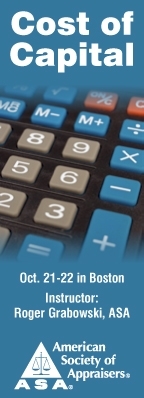
| Is the Pomeroy Bill dead? Will Frazier (HFBE, Dallas) traveled to Washington, D.C. last week for a meeting of the IRSAC (Internal Revenue Service Advisory Committee). He reports to BVWire that “the only news is that there is no news” on trust and estates legislation. “I met with some Congressional staffers after my meeting—and Capitol Hill is preoccupied with healthcare…the Pomeroy Bill is dead and not going anywhere. There is no legislation pending that has any valuation discount provisions in it.” However, this does not mean that any future estate tax legislation will not include these elements,” he adds. “It’s also fairly clear that no permanent estate tax legislation will happen this year. A bill WILL be passed that extends 2009 rules into 2010. So, the ‘death’ tax is NOT going away.” This leaves two unanswered questions. First, will the 2009 estate tax legislation extend for one or two years—giving Congress enough time to enact real estate tax change in either 2010 or 2011? Second—if the extension lasts just one year, will Congress really enact permanent legislation during an election year (2010)? “If Congress fails to act in 2010, the existing estate tax law will sunset and, in 2011, the estate tax comes back with a vengeance: a 55% rate and a pathetically low $1 million exemption,” Frazier says. “Many on Capitol Hill, including Charles Rangel (D-NY), Chairman of the House Ways & Means Committee—through whose hands all estate tax legislation must pass—would love to see this result.” Here’s how Frazier handicaps the future:
“I would not advise placing any bets on my predictions,” he quips. A better bet: there’s still time to attend the 2nd Annual University of San Diego School of Law, Business Valuation and Tax Conference this Friday October 9, 2009. A reasonable comp checklist to survive any It’s often the most important variable in a business appraisal assignment: the selection of what constitutes reasonable compensation for employee-owners. “For closely held businesses, in many cases, no single operating expense impacts the bottom-line profit as much as officer’s compensation,” said Ron Seigneur ((Seigneur Gustafson LLP, Lakewood, CO) at the recent Summit on Business Valuation in Divorce, co-sponsored by BVR/NACVA/ASA in Chicago. Adjustments to owner-income don’t only occur in divorce cases, of course, but also to normalization assumptions in closely held business appraisals; measurement of personal versus enterprise goodwill; and valuation of non-competes. “Another emerging area is in evaluating excess or inadequate compensation challenges by the IRS,” Seigneur said. “The adjustment for reasonable comp is critical—and at the same time, one of the most difficult to quantify.” Appraisers frequently use historical information to determine current compensation—but when applying market and other survey data, “be careful,” said co-presenter Sharyn Maggio, (Maggio & Co., Eatontown, NJ). “Misuse of the data can lead to incorrect valuations.” “You have to look at the salary studies to see how stale the information has become in the current economy,” Seigneur added. “Many surveys use data that are already a year old by the time of publication.” You also have to look at what was happening in the industry and the economy when the data was collected compared to now. Know the data and what’s included. In the MGMA surveys, for instance (Medical Group Management Assn.), there’s a bias toward salaried doctors working for large universities or health sciences institutions. Appraisers should also check whether the data include: salary, bonus, stock options and other deferred compensation. To review the reliability of any survey, Seigneur and Maggio suggested a 12-point checklist, based on a recent article in the Business Valuation Update™. “If you use this checklist and can answer the questions, you’ll survive cross-examination,” Maggio said. The checklist is now posted first among the numerous free resources at BVResources.com.
For those who were unable to attend last week’s BVR Divorce Summit, BVR is hosting a special recast of three of the Summit’s best sessions, followed by live Q&A with conference co-chairs Jay Fishman, Sharyn Maggio, and Bill Morrison. In 100-minutes you’ll hear:
Attendees will also receive complete presentation materials from the Summit. It all kicks off ten days from now, at 10:00 am PT/1:00 pm ET on Friday, October 16, 2009. To find out more for this 2-CPE event, or to register, click here. Just in time: new FASB updates NAV of Due to the current complexities and practical difficulties in estimating the fair value of alternative investments—such as hedge funds, PE and VC funds, real estate and offshore fund vehicles, and fund of funds—the Financial Accounting Standards Board (FASB) has just released Accounting Standards Update No. 2009-12, Fair Value Measurements and Disclosures (Topic 820): Investments in Certain Entities That Calculate Net Asset Value per Share (or Its Equivalent). The amendments affect all reporting entities that hold an investment that is required (or permitted) to be measured or disclosed at fair value on a recurring or non-recurring basis, and also meet two criteria: 1) the absence of a readily ascertainable fair value; and 2) the investment’s activities, ownership, pooling of funds, and reporting functions display certain traits, described more fully in the body of the update. The guidelines discuss current U.S. GAAP requirements regarding investment companies (Topic 946) and fair value measurements (Topic 820), and permit, as a “practical expedient,” a reporting entity to measure the fair value of an alternative investment on a net asset value (NAV), per-share basis if the calculation is consistent with GAAP standards and if it provides certain additional disclosures. This “practical expedient” reduces complexity and cost of applying Topic 820 while improving “consistency and comparability,” the summary says. The additional disclosures “enable users of financial statements to understand the nature and risks of investments” and whether the investments are likely to be sold at amounts different from net asset value per share. The new guidelines take effect for interim and annual periods ending December 15, 2009. Early application is permitted for earlier statements that have not yet been issued. More on Microsoft: a tale of two cases If you’ve been following our coverage of Microsoft’s recent success in Lucent Technologies, Inc. v. Gateway, Inc. (see BVWire# 84-2)—in which the court tossed out a $358 million verdict against the mega-computer company for lack of sufficient financial evidence supporting the patent infringement claims—then you may interested in a new case, in which the jury assessed $200 million against Microsoft for patent damages. In i4i Ltd. Partnership v. Microsoft Corp., 2009 WL 2449024, the jury found that some of Microsoft’s WORD 2003 products and all of WORD 2007 infringed a patented XCL editing technology. To calculate damages, it heard from two experts: one who conducted a market survey to determine consumer usage of the accused products; and a second who looked at a benchmark product (XMetaL) to develop a reasonable royalty rate. On appeal, Microsoft argued that the survey was unreliable hearsay, the benchmark product was not a valid comparable, and the damages expert used an improper rule of thumb (assuming the patentee would receive 25% of the infringer’s profits). The federal district court (E.D. Tex.) disagreed, however, and affirmed the $200 million award on August 11, 2009. Microsoft must have had its appeal papers ready, because not two week later, it delivered its opening brief to the U.S. Court of Appeals for the Federal Circuit—the same court that reversed the award jury in Lucent v. Gateway. Interestingly, Microsoft’s brief asserts that the expert’s survey was based on “just” 19 telephone responses, and the XMetaL comparable sold for triple the amount of most WORD products. The plaintiff filed its response on Sept 9, 2009, followed by Microsoft’s reply on September 14, 2009. Stay tuned… New edition of USPAP revises Ethics rule The Appraisal Foundation (TAF) just released the 2010-2011 Uniform Standards of Professional Appraisal Practice (USPAP), effective January 1, 2010 through December 31, 2011. As with prior editions, the new release includes guidance from the Appraisal Standards Board (ASB) in its USPAP Advisory Opinions and the USPAP Frequently Asked Questions (FAQs). Significant changes include:
“The ASB made several revisions that we believe improve the clarity, understandability and enforceability of USPAP,” says 2009 ASB chair Sandra Guilfoil. Clearly the revisions to the Ethics Rule are the most controversial. “The ASB must always be mindful of its mission to promote and maintain a high level of public trust,” Guilfoil added. “This new requirement allows the client to determine whether there may be any real or perceived conflicts of interest prior to engaging the appraiser in the assignment.” Although the revisions won’t take effect until next year, TAF is encouraging appraisers to familiarize themselves with the changes now. Copies are available at TAF (print for $75 and electronic copies for $60). New article from CFA on IFRS convergence
Copies of the complete article are available here. Will there be more ESOP valuations in the future? The current M&A market for private companies is defined by consolidated buyers, says a new article, “The Power of the ESOP in Acquisitions,” by I-banker William Stewart (PCE Companies). Especially in today’s credit-strapped environment, ESOP-owned companies may be the most effective consolidators, given their “employee first” culture, their stronger qualifications for bank financing, the tax advantages to the selling shareholders, and the superior value of the target’s cash flow to the ESOP (as compared to the target). For example, in “standard” acquisitions, the acquiring company will use the target’s earnings to repay any sale financing and other debt, with hopes of realizing additional return through the combined synergies and growth of the business. However, if the acquiring business is an ESOP, it can pay down the debt must faster by eliminating the target’s historical income tax, resulting in better returns. “These compelling economics are the biggest reason why we’ve seen companies that are owned by ESOPs become active acquirers,” Stewart writes. “In the best cases, the buyer wins with superior rate of return, the seller wins by maximizing after-tax proceeds, and the employees win by becoming owners through the ESOP.” And business appraisers can win by adding value to their compliance, consulting, transfer pricing and other services to their ESOP clients.
To ensure this email is delivered to your inbox, Copyright © 2009 by Business Valuation Resources, LLC
|
|
|



